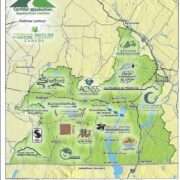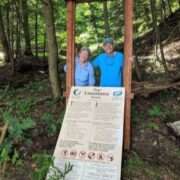View our March newsletter on Mailchimp
Archive for month: March, 2021
The Massawippi Conservation Trust (MCT) has been considerably active over the past few years for the protection of the natural environments of its territory, and more particularly within the conservation core identified on the western shore of Lake Massawippi. Out of a natural habitat core covering 1,200 hectares, 36.7% of the natural environments are protected in perpetuity thanks to the work of the MCT. This is remarkable!
To achieve these important ecological gains, MCT has been working for over ten years in concert with Appalachian Corridor. From its offices in Eastman, the multidisciplinary team of professionals offers its 17 affiliated members a range of services for the implementation of conservation actions in its territory of action, which extends from Granby to Sherbrooke and south to the Canada-U.S. border. Over the past 18 years, Appalachian Corridor and its partners have protected 14,619 hectares of our rich and precious regional territory!
Among other things, when the MCT wishes to acquire a piece of land for conservation purposes in perpetuity, the Appalachian Corridor team is active in supporting the project by conducting an assessment of the ecological value of the area.
During its visits, the Appalachian Corridor knowledge acquisition team seeks to obtain a complete picture of the property’s biodiversity and sensitive environments. This is why it travels throughout the territory in search of species in a precarious situation, including birds, amphibians, reptiles, mammals and flora. Wetlands, areas with steep slopes, watercourses and mature stands are sensitive areas where the greatest biodiversity and sensitive species are often found. Biologists always keep their eyes and ears open so as not to miss anything.
Old maple groves are among the important targets to be evaluated on the land, especially those that are less accessible because they have usually suffered less disturbance and have more integrity. These maple groves are often rich and shelter a beautiful diversity of species, particularly plant species, some of which are in a precarious situation, such as wild garlic, which is only found in this type of habitat. The red oak stands present in this core habitat are another ecological element of interest in this sector since this type of forest stand is quite rare in our region. These stands are now only found on a few mountain peaks or slopes.
Streams are also one of the biologists’ favorite targets, particularly within the FCM’s core habitat because they are mountain streams where clear, cold and well-oxygenated water flows towards Lake Massawippi. These streams are home to several wildlife species, including amphibians that are very sensitive to the quality of the water and their environment – the northern dusky salamander and the purple salamander. The northern dusky salamander is likely to be designated threatened or vulnerable in Quebec, while the purple salamander is designated vulnerable.
The protection of streams and riparian zones are very important for these species, in addition to being essential to maintaining water quality in Lake Massawippi. It is probably due to the presence of these streams within the core habitat that a population of lake trout, also known as Gray Trout , is maintained in Lake Massawippi since this fish requires a habitat that has cold, clear, well-oxygenated water and where the pH is higher than 5.4.
Clément Robidoux, Conservation Director and Victor Grivegnée-Dumoulin, Biologist, Knowledge Acquisition Coordinator 

The Wilcox family,1955 on Lake Massawippi. Brandy (the dog), Bart, Gordon and Tom. Dr. Bud Wilcox on water skis. Who took the picture? Libby Wilson Wilcox sitting on the bow. The Wilcox camp in the background.
Tom Wilcox is a founding trustee of the Massawippi Foundation and the Massawippi Conservation Trust.
Tom is not new to Lake Massawippi, in fact he is a fifth generation American who is part of the long tradition of Americans who have been coming to Canada to escape the heat of the big city and enjoy life at the lake. His grandfather bought land 120 years ago and his father built the camp after the end of World War two.
When asked for his most memorable moment during his tenure on the board, Tom, who overflows with enthusiasm and love for the area, couldn’t stop at just one or two examples.
Peak memorable moments include:
The recognition of the Foundation and the Trust as legal entities.
- Around 2010, Tom and a small group of individuals, sprang into action after noticing that a large tract of land on the mountain had been acquired for development. These neophytes decided that they needed to create a legal entity to preserve the pristine forest and ecologically sensitive watershed.
The acquisition of Louise Ransom’s property.
- Tom was a neighbour of Louise Ransom (February 2021 article). He spoke to her for years about conservation, trying to get her to safeguard her land. At first he tried to get it under the protection of the Nature Conservancy of Canada but the piece was too small for them to consider. A small but significant parcel of land which Tom calls an anchor, pivotal to the conservation of the watershed of the lake.
The Challenge Grant to build the working capital of $ 100,000.
- For every $2 raised a small group of donors were prepared to give $1 towards the goal. The money was needed to operate, buy land, pay taxes and legal fees etc. Tom, as President of the Baltimore Community Foundation, lent his expertise to the group. They were successful not only because of their personal passion but because donors recognised the need to protect and preserve the land for the community and future generations.The dedication of the Massawippi trail at the top of Côte du Piémont.
The dedication event was the shining jewel in the crown, commemorating all of the fundamental beliefs of the founding members and the donors.
- First Nation, English, French, local residents, politicians, people of all stripes came together to celebrate the opening of the trails which gave the general public access to what was once private property. It was a recognition of the conservation values that the Wardman family and others like Louise Ransom. Métis Paul Carignan and his wife Sylvia Bertolini sang an Anishnabe Sun Song. Their presence commemorated the original Abenaki people whose territory included this land. The land was recognized for its value and returned to the public as a protected space.
From the citizen of Baltimore who settled in Baltimore Bay (on the west side of the lake) comes a heartfelt message for the community. The trails are the democratisation of the conservation acquisitions. The conservation efforts are not about creating green play grounds for the rich but rather something for the public. The idea is that private property is made available for public use. A concept which is more popular in the United States.
According to Tom, everyone who has grown up on the lake lived in fear of roads (a.k.a. development) appearing on the mountain. When he was a little boy, there were no roads to Blueberry point or northwards. Reaching their cottage was and still is by water access only. Properties would be worth ten times more if there were road access. The entire landscape would be different. And that is not why his grandfather bought the land 120 years ago.
Tom and his wife hope that the Wilcox camp will stay in the family and perpetuate the now six generations of family tradition. The surrounding property is protected by a conservation servitude. Along with the deep respect from the long family tradition comes the idea that through the Conservation Trust the area will be preserved for future generations and the public can have responsible access to the land. People cannot build more cottages on the land however the property can be sustained complimentary activities can be created.
To end the interview Tom said, “ General Motors is going to be carbon neutral by 2035 and all electric by 2045 so he would like to think that boats on Lake Massawippi could be all electric and quiet, a model, an eco-tourism center being one with nature like the Abenakis who lived here before we invaded. They were one with nature.”
Can we be?

Latest Articles
 Reflections on Some Common Nature “Do’s and Dont’s” | Part 2July 3, 2024 - 9:10 am
Reflections on Some Common Nature “Do’s and Dont’s” | Part 2July 3, 2024 - 9:10 am A beautiful day, out of the office and off the hiking trailsJuly 2, 2024 - 10:31 am
A beautiful day, out of the office and off the hiking trailsJuly 2, 2024 - 10:31 am Trails Essay – May 2024 by Matthew ClearyMay 21, 2024 - 1:23 pm
Trails Essay – May 2024 by Matthew ClearyMay 21, 2024 - 1:23 pm




